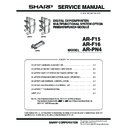Sharp AR-F16 (serv.man2) Service Manual ▷ View online
2-1
CHAPTER 2 FINISHER UNIT BASIC OPERATION
I.
BASIC OPERATION
A.
Outline
The finisher is designed to deliver copies arriving from its host machine, and its modes of
delivery include simple stacking, job offset
(Note)
, and staple.
All operations involved in these modes are controlled by the finisher controller PCB, according
to the appropriate commands from the host machine.
In the case of the Saddle Finisher, copies from the host machine may be routed to the saddle
stitch unit.
Swing guide drive system
Alignment drive system
Stapler drive system
Delivery drive system
Feeder drive system
Shutter drive system
Tray drive system
Tray drive system
Saddle stitch unit control system
(Saddle Finisher)
(Saddle Finisher)
Control system
Figure 2-101
Note:
The term job offset refers to shifting each sorting job, separating a single
stack into several stacks.
stack into several stacks.
2-2
CHAPTER 2 FINISHER UNIT BASIC OPERATION
B.
Outline of Electrical Circuitry
The finisher’s sequence of operation is controlled by the finisher controller PCB. The finisher
controller PCB is a 16-bit microprocessor (CPU), and is used for communication with the host
machine (serial) in addition to controlling the finisher’s sequence of operations.
machine (serial) in addition to controlling the finisher’s sequence of operations.
The finisher controller PCB responds to the various commands coming from the host machine
through a serial communications line to drive solenoids, motors, and other loads. In addition, it
communicates the finisher’s various states (information on sensors and switches) to the host ma-
chine through a serial communications circuit.
communicates the finisher’s various states (information on sensors and switches) to the host ma-
chine through a serial communications circuit.
In the case of the Saddle Finisher, the finisher controller PCB not only communicates with the
saddle stitch controller PCB but also communicates the saddle stitch unit’s various states (informa-
tion on sensors and switches) to the host machine.
tion on sensors and switches) to the host machine.
The ICs used on the finisher controller PCB are designed for the following:
●
IC1 (CPU)
Controls sequence of operations.
Controls sequence of operations.
●
IC2 (EP-ROM)
Backs up adjustment values.
Backs up adjustment values.
●
IC3
Contains sequence programs.
Contains sequence programs.
●
IC6/IC7 (RAM)
Backs up initial setting data.
Backs up initial setting data.
●
IC4 (communications IC)
Communicates with the host machine and the saddle stitch unit.
Communicates with the host machine and the saddle stitch unit.
●
IC9 (regulator IC)
Generates PWM.
Generates PWM.
Figure 2-102 shows the flow of signals between the finisher and the options controller.
2-3
CHAPTER 2 FINISHER UNIT BASIC OPERATION
IC1
CPU
IC2
EEP-ROM
IC4
IC
IC3
EP-ROM
IC6/IC7
RAM
IC9
Saddle stitch
controller PCB
(Saddle Finisher)
controller PCB
(Saddle Finisher)
Punch driver PCB
(Puncher unit (option))
(Puncher unit (option))
Host machine
(DC controller PCB CPU)
(DC controller PCB CPU)
Finisher controller
PCB communication
PCB communication
Regulator IC
Connecting with inserter
Motor
Solenoid
Switch
Sensor
IC1
CPU
IC2
EEP-ROM
IC4
IC
IC3
EP-ROM
IC6/IC7
RAM
IC9
Saddle stitch
controller PCB
(Saddle Finisher)
controller PCB
(Saddle Finisher)
Punch driver PCB
(Puncher unit (option))
(Puncher unit (option))
Inserter driver PCB
(Inserter unit (option))
(Inserter unit (option))
Host machine
(DC controller PCB CPU)
(DC controller PCB CPU)
Finisher controller
PCB communication
PCB communication
Regulator IC
Motor
Solenoid
Switch
Sensor
Figure 2-102
2-4
CHAPTER 2 FINISHER UNIT BASIC OPERATION
C.
Inputs to and Outputs from the Finisher Controller PCB
1.
Inputs to the Finisher Controller PCB
Figure 2-103
Click on the first or last page to see other AR-F16 (serv.man2) service manuals if exist.

